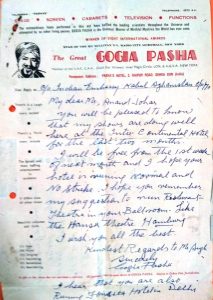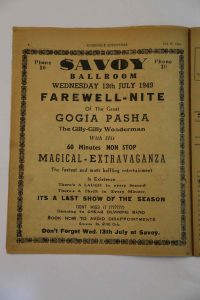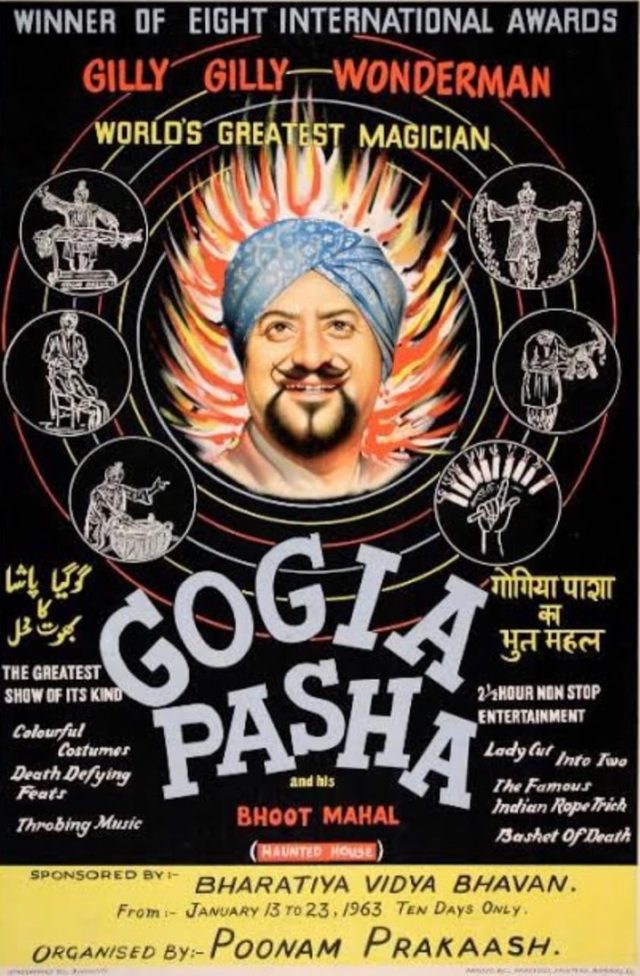 By: Ganesh Saili
By: Ganesh Saili
Oftener than not, life can be much stranger than fiction as I discovered while surfing through material and chanced upon a letter written by Gogia Pasha, a Dehradun magician, in which he pleads with Anand Jauhar, my friend, who once owned the Savoy Hotel and asks Nandu, as friends affectionately called him, to host magic shows in the ballroom. Reading the letter took me back several decades in time when, while still in college, I happened to catch one of these shows and saw the velvet curtain part to reveal the legendary showman. He was dressed in shimmering robes with a flashy turban topping the ensemble. He had his signature goatee and twirled moustaches that were meant to give him a slightly menacing look, which they did to amazing effect. Slipping with ease among the tables, he chit-chatted with the audience, effortlessly becoming part of it. Suddenly he chanted ‘Gilly! Gilly! Gilly!’ (the Egyptian bazaar slang for magic) as he paused beside a nawab to produce a cascade of coins from the man’s beard and later fished out some lingerie from the poor man’s pocket. Nawab Saab turned red with embarrassment while the resultant laughter almost bought the roof down.

Gogia Pasha’s story begins with the partition of the sub-continent, when Dhanpat Rai came from Gogia Mohalla in Multan, along with his father, to Dehradun. Realising that his father’s jewellery business was floundering, for in those tough times there were few takers for his father’s delicate Meenakari work, he decided to make his fortune elsewhere. He set off for England in the 1920s and in Blackpool he chanced upon the conjurer Owen Clerk. The brash youngster had no hesitation in showing the senior magician ways in which he could improve upon his tricks. Clerk took him under his wing and before he, Clerk, passed away in 1929, he gifted Dhanpat his collection of props that were shipped like a treasure-trove to India. Taking the moniker ‘Gogia Pasha’ – a portmanteau of his village name and ‘Pasha’ which in Persian meant a nobleman, he set out to conquer the world with performances that included a combination of comedy and harmless natter. He was the first one to introduce dancers on the stage to keep the audience entertained while he prepared for his next trick.
In 1936, after a show at the Granville theatre in London, where ball-swallowing and palming led up to the production of a string of flags from the mouth; followed by an exhibition of marksmanship with bow and arrows; and then a round-sided flat-bottomed basket of the Indian street conjurer was introduced where a young assistant would be seated and folks began to call him the ‘Port Said conjurer’. News reports tell us: ‘A cloth is then thrown over the basket with Gogia sitting in it, and then a business like sword was repeatedly plunged through and through the basket, but we breathe a sigh of relief when a moment later the dusky helper emerges unscathed.’

Savoy Hotel
Of course, towards the end of the show he mingled with the audience, and magically discovered ‘various articles of intimate feminine attire’ in an unsuspecting gentleman’s waistcoat – a revelation that ‘vastly amused the ladies.’ While in Germany, he presented a coin act called The Man with a Hundred Million Dollars which intrigued and amused the Fuhrer, Adolf Hitler, who jokingly asked him: ‘Why don’t we make you the Treasurer of the Third Reich?’
At the end of the Great War, he travelled throughout Europe, Asia and Australia. Post 1950, perhaps because of competition from other magicians who had begun to do similar shows, he began to use titles like World Renowned Egyptian Master of Magic and The World’s Greatest Entertainer. Soon after, he introduced a combination of western and oriental tricks like X-Ray Eyes, Tongue Cutting, Flying Rani, the Cabinet of Dr. Albini, King Pharaoh’s Dream, Wonders of the Pyramids, the Haunted Hotel and the Basket of Death.
Gogia spent the last days of his life in Dehradun’s Madhoram Building on Raipur Road, a stone’s throw from Survey Chowk, where the final curtain call came in 1976 for Dhanpat Rai of Gogia Mohalla. Farewell, Gilly! Gilly! Man. Your shows were indeed magical.
Ganesh Saili born and home-grown in the hills belongs to those select few whose words are illustrated by their pictures. Author of two dozen books; some translated into twenty languages, his work has found recognition worldwide.








